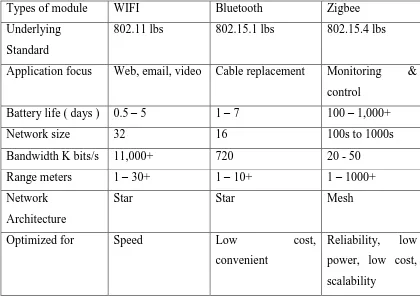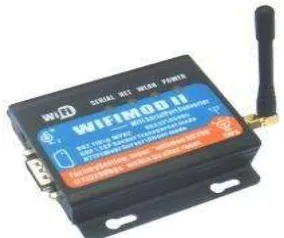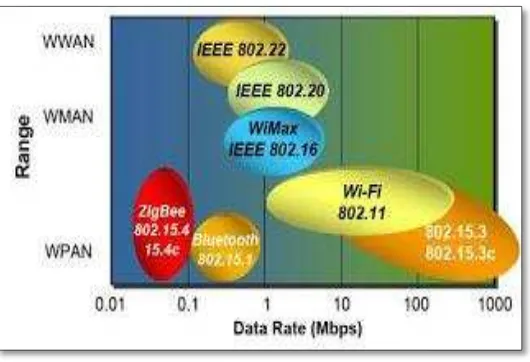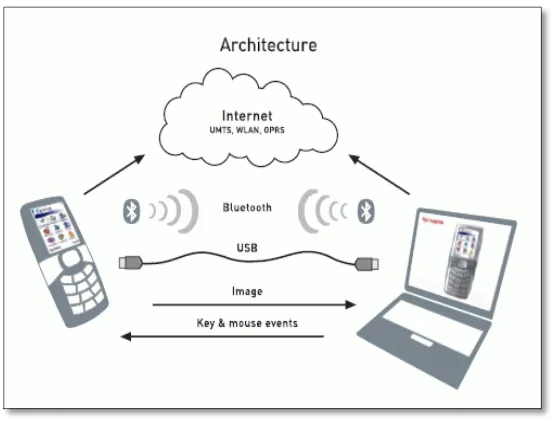DEVELOPMENT OF WIRELESS NETWORK USING ZIGBEE
NURUL FARAH ATIQAH BINTI ROZAHI
B051010085
UNIVERSITI TEKNIKAL MALAYSIA MELAKA
UNIVERSITI TEKNIKAL MALAYSIA MELAKA
DEVELOPMENT OF WIRELESS MONITORING NETWORK
USING ZIGBEE
This report submitted in accordance with requirement of the Universiti Teknikal
Malaysia Melaka (UTeM) for the Bachelor Degree of Manufacturing Engineering
( Robotic and Automation ) (Hons.)
By
NURUL FARAH ATIQAH BT ROZAHI B051010085
880126 – 04 – 5166
FACULTY OF MANUFACTURING ENGINEERING
DECLARATION
I hereby, declared this report entitled “ Development of Wireless Mesh Network using
Zigbee for Monitoring Manufacturing Activities” is the results of my own research except as cited in the references.
Signature : ………
Author’s Name : ………
APPROVAL
This report is submitted to the Faculty of Manufacturing Engineering of UTeM as
a partial fulfillment of the requirements for the degree of Bachelor of
Manufacturing Engineering ( Robotic and Automation ) (Hons.). The
member of the supervisory committee is as follow:
………
APPROVAL
This report is submitted to the Faculty of Manufacturing Engineering of UTeM as
a partial fulfillment of the requirements for the degree of Bachelor of
Manufacturing Engineering ( Robotic and Automation ) (Hons.). The
member of the supervisory committee is as follow:
………
(Official Stamp of Principal Supervisor)
………
i
ABSTRAK
ii
ABSTRACT
As we know, mostly the current methods of monitoring manufacturing activities are done in manual ways. The main objective of this project is to build a Wireless Monitoring Network using Zigbee to monitor manufacturing activities. The emerging of all development system has become important to improve production and minimize the cause of implementing network and caused by waste. This project aims to investigate
Zigbee’s capabilities as Wireless Network which the study will look into Zigbee’s
iii
DEDICATION
iv
ACKNOWLEDGEMENT
v
Table of Contents v-vi
List of Table vii
List of Figures viii-xi
CHAPTER 1: INTRODUCTION
1.1 Project Background 1- 6 1.2 Problem Statement 6-7
1.3 Objective 7
1.4 Scope 7
CHAPTER 2 : LITERATURE REVIEW
2.1 Wireless Network 8-10
2.2 Research on Related Paper 10-19
vi 3.4 Development of Monitoring System using Visual Basic
CHAPTER 4 : RESULTS
4.1 Experimental Setup 4.1.1 Hardware Circuit 4.1.2 Hardware Configuration 4.1.2 Environmental Setup 4.2 Result and Discussion
CHAPTER 5 : CONCLUSION AND FUTURE WORK
vii
LIST OF TABLES
Figures Details Pages
1.1 Comparison between WIFI, Bluetooth, Zigbee 4 2.1 The standard of IEEE 802.11 family 14 2.2 Comparison Between Wireless Access Technology 15-16 2.3 Comparison between application Zigbee, WIFI,
Bluetooth
19 2.4 Comparison between XBee and XBee Pro Modules 22
3.1 Setup for 3 Zigbee’s 28
3.2 AT Command Mode 31-32
3.3 Etching Process 36-39
4.1 Addresses assign for each point 45
4.2 Parameter of Working distance (Line of Sight) 47 4.3 Parameter of Working distance (With Obstacle) 47 4.4 Parameter of Accuracy (Internal-Line of Sight for short
distance)
48
4.5 Parameter of Accuracy (Internal–Line of Sight for far distance)
49
4.6 Parameter of Accuracy (External–With Obstacle for short distance)
50
4.7 Parameter of Accuracy (External–With Obstacle for far distance)
50
viii
LIST OF FIGURES
Figures Details Pages
1.1 Local Area Network ( LAN ) 2 2.2 Bluetooth Architecture 9 2.3 WIFI Architecture 10 2.4
2.5
Area coverage of different wireless access technologies Inquiry Procedure Example
13 18 2.6 Zigbee Mesh Network Architecture 20 2.7 Zigbee application profile 21 2.8 XBee with Starter Kit 23 2.9 Concept of Jidoka 24 2.10 The Kaizen Umbrella 25 3.1 Development of Wireless Monitoring System is using Zigbe 26 3.2 3.4 System Data Flow Diagram in a UART‐interfaced
environment (Low‐asserted signals distinguished with horizontal line over signal name)
28
3.5 Connection between PIC16F877A microcontroller and Zigbee
29
3.6 Hardware connection microcontroller SK40C+16F877A and SKXBee
ix
3.7 PLC will send data to a PIC microcontroller 30
3.8 X-CTU setup 30
3.11 AT Command and Parameter 32
3.12 X-CTU Configuration Mode 32
3.13 Configuration between Two Zigbee 33 3.14 Circuit Design of the Terminal 34 3.15 PseudoCode of PIC 40 3.15 PseudoCode for GUI 41 3.16 Monitoring System using Visual Basic for Graphical
User Interface
42
1
CHAPTER 1
INTRODUCTION
1.1
Project Background2 Figure 1.1: Local Area Network (LAN)
(Source : <http://www.dudleysenanayakacc.blogspot.com>)
Figure 1.2: Wide Area Network (WAN)
3 Figure 1.3: Metropolitan Area Network (MAN)
(Source : <http://www.dudleysenanayakacc.blogspot.com>)
A Wireless Mesh Network (WMN) is a network of wireless which is more mobile and self organized in arbitrary and temporary network topologies. The communication of this network is made up from radio nodes and organized in a mesh topology. Wireless Mesh Network is significantly upgrading the performance of LANs, PANs and MANs. The application of Wireless Mesh Network is must be simple, energy efficient, scalable, robust and cost effective over a certain geographic area. Unlike cellular network which is the failure of a single base station are leading to unavailability of communication. WMN is built from peer radio devices and
4 Table 1.1: Comparison between WIFI, Bluetooth, Zigbee
(Source: ZigBee Alliance)
Types of module WIFI Bluetooth Zigbee Underlying
Standard
802.11 lbs 802.15.1 lbs 802.15.4 lbs
Application focus Web, email, video Cable replacement Monitoring & control
5
for quick assessment of changes in the absolute water content of air, allowing estimation of future water loss, and detection of condensation on the product. According to Bhavneet et al (2007), WIFI is a data transmission designed to provide network access between computing devices by using radio waves rather than cable infrastructure. The network type is 802.11 could transfer the data up to 11 megabits per second (Mbps) and the WLAN hardware built around 802.11g was quickly embraced by consumers and businesses seeking higher bandwidth. The Figure 1.4, 1.5 and 1.6 shows the WIFI module, Bluetooth dongle and XBee Pro antenna.
Figure 1.4: WIFI moduleSerial (RS232) Figure 1.5: Mini USB 2.0 Bluetooth
(Source: <http://www.toboc.com>) Dongle (Source: <http://www.basco.com>)
Figure 1.6: XBee Pro 60mW Wire Antenna
(Source: <http://www.cytron.com.my>)
6
serious enough to break down. The monitoring technique involved the designing and sensing arrangement on industrial plant together with data acquisition and analysis system plus with predictive and diagnostic method. Although to engineer and manufacture is human, but to fulfill the consumer perception towards order with the criteria such as total quality, reliability, health and safety, environmental issues, energy conservation and cost of ownership, the automatic system and equipments will be used to monitor manufacturing activities. For example the speeds of rotating machinery need high capabilities to control and process the system. Recently, monitoring manufacturing activities have become critically important to achieving cost – effective plant maintenance, economics of production and productive production (A. Davies, 1998).
This research project will be focused to develop Wireless Mesh Network using the Zigbee application for monitoring manufacturing activities. The reasons using Zigbeebecause it is carried only low data rate. This Zigbee is the most suitable application to use because its reliability, low power, low cost and thus the application are focusing on monitoring and control is suitable to the research project which is to monitor manufacturing activities.
1.1 Problem Statement
7
have minimal change in infrastructure as it works using WLAN instead of wired. However, implementation of WIFI is complicated compares to other wireless technique. Meanwhile Bluetooth only covers a short-range distance which is 1 to 10 meters only. Therefore, this project will focus on applying Zigbee in monitoring the manufacturing environment where the machines are located in different locations. By using Zigbee, the cost to implement is more reasonable and, cheaper than WIFI.
1.3 Objective
a. To develop a manufacturing monitoring system using visual basic, Zigbee and microcontroller.
b. To evaluate the system performance.
1.4 Scope
a. The simulation of PLC machine will be count using simple switches as the act of monitoring manufacturing activities.
b. Distance to be covered will be limited to 50m radius.
8
CHAPTER 2
LITERATURE REVIEW
2.1
Wireless NetworkIn this project, the wireless network protocols to be focused are showed in Figure 2.1:
1. Zigbee 2. WIFI 3. Bluetooth
Figure 2.1: Types of Wireless Network
9
In Zigbee, it is a wireless network with an Internet Protocol (IP) IEEE 802.15.4 MAC / PHY radio technology in 2.4 GHz unlicensed frequency band and enables worldwide operation, low power consumption cost and convenience. The Zigbee tech is intended to be simpler and less than WPANs such as Bluetooth. Zigbee is targeted at radio - frequency (RF) applications that required a low data rate, long battery life and a long transmission range compared to Bluetooth. Zigbee applications are more focused on monitoring and control such as control wireless light switches, electric meter with in home display and other consumer and industrial equipment (Jon Adams, 2006).
While Bluetooth is a wireless network with an Internet Protocol (IP) IEEE 802.15.1 to 2.4 GHz range for the use of low power radio communications to link phones, computer and other network devices in short distances without wires. Bluetooth is simply designed to support simple wireless networking of personal consumer devices such as cell phone, PDA, and wireless headsets. To compare Bluetooth with Zigbee, Bluetooth cover the short distance typically 10 meters and communicate less than 1Mbps, slower and support fewer devices. The Bluetooth application more focused on transmit data with low data rate and it is cable replacement. The Figure 2.2 had shown the Bluetooth transmission.
Figure 2.2: Bluetooth Architecture





